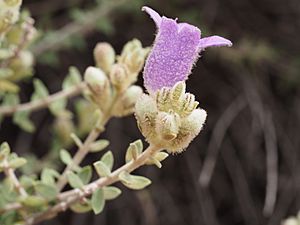Frontage poverty bush facts for kids
Quick facts for kids Frontage poverty bush |
|
|---|---|
 |
|
| Eremophila malacoides leaves and flower | |
| Scientific classification | |
| Genus: |
Eremophila (plant)
|
| Species: |
malacoides
|
The Eremophila malacoides, also known as the frontage poverty bush, is a type of flowering plant. It belongs to the figwort family, called Scrophulariaceae. This plant is special because it is endemic to Western Australia, meaning it only grows there naturally.
This shrub has grey-green leaves that are quite hairy. Its flowers are usually a pretty lilac to purple color. Sometimes, you can even find a form of this plant with yellow flowers!
Contents
What It Looks Like
The frontage poverty bush is a greyish, spreading shrub. It has many tangled branches and usually grows to be less than 1 m (40 in) tall. Both its leaves and branches are covered with soft, grey, matted hairs.
The leaves grow one after another along the branches. They are mostly oval or egg-shaped. Each leaf is about 5–15 mm (0.2–0.6 in) long and 2.5–7 mm (0.1–0.3 in) wide.
The flowers grow one by one where the leaves meet the stem. They don't have a stalk. Each flower has 5 hairy, overlapping, lance-shaped sepals. Sepals are like small leaves that protect the flower bud. These sepals are 5.5–7 mm (0.2–0.3 in) long. The hairs on the outside of the sepals are yellowish and form a thick, loose mat.
The petals are the colorful parts of the flower. They are 20–32 mm (0.8–1 in) long and are joined together at the bottom to form a tube. The outside of this tube is lilac or purple. Inside, it's white with purple spots. In the Granite Peak area, these flowers are usually yellow.
The outside of the flower tube and its petal tips are hairy. The inside of the petal tips is smooth, and the inside of the tube is full of long, soft hairs. The 4 stamens, which are the parts that produce pollen, are completely hidden inside the petal tube.
This plant flowers after it rains, usually from April to November. After flowering, it produces dry, woody, hairy, oval-shaped fruits. These fruits are about 4.5–6 mm (0.18–0.24 in) long.
How It Got Its Name
The scientific name Eremophila malacoides was first officially described by Robert Chinnock in 2007. This description was published in a book about the plant family Myoporaceae.
The second part of the name, malacoides, comes from ancient Greek words. Malae- or malakos means 'soft', and oides or eidos means 'form of' or 'shape'. So, malacoides means 'soft form' or 'soft-like'. This name refers to the soft hairs found on the branches and leaves of this plant.
Where It Grows
This type of eremophila plant grows in Western Australia. You can find it between the towns of Meekatharra and Leonora. It grows in areas called the Gascoyne and Murchison biogeographic regions.
It usually likes to grow in salty areas. These places often get flooded when it rains a lot.
Is It Endangered?
The Eremophila malacoides is not considered to be in danger. The Western Australian Government Department of Parks and Wildlife has classified it as "not threatened." This means there are enough of these plants in the wild, and they are not at risk of disappearing.
Growing It in Your Garden
The frontage poverty bush is a great plant for gardens. This small, compact shrub almost always has flowers, making your garden look pretty. It can grow well in many different types of soils, even heavy or salty ones. It can also handle both frost and dry conditions.
You can grow new plants from cuttings taken from an existing plant. In most gardens, it will grow well on its own roots. It's a tough garden plant that will benefit from a small amount of fertilizer in the spring.
Images for kids
-
E. malacoides growing near Wiluna



